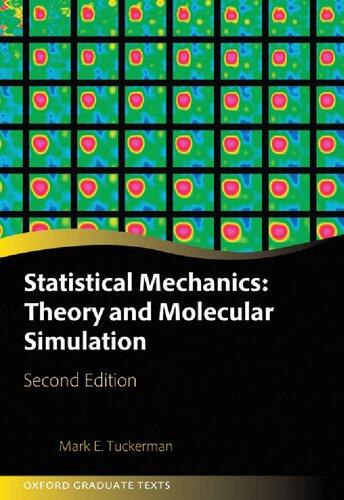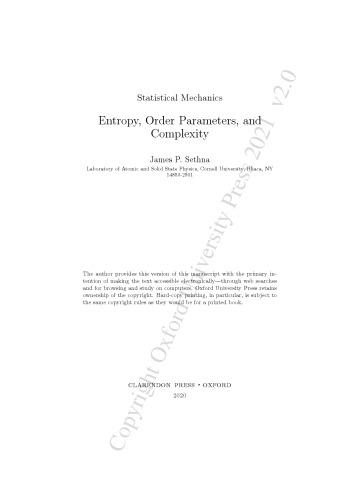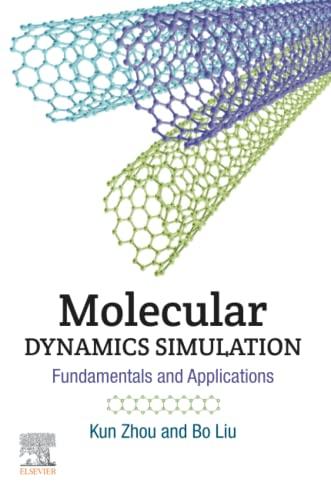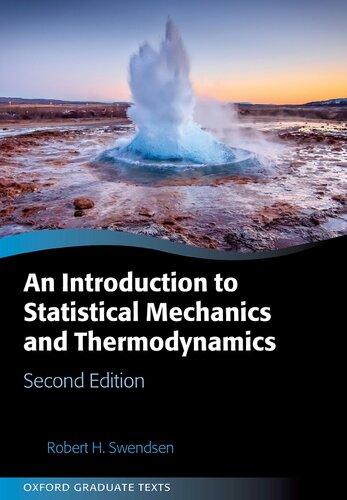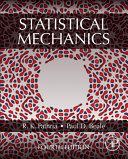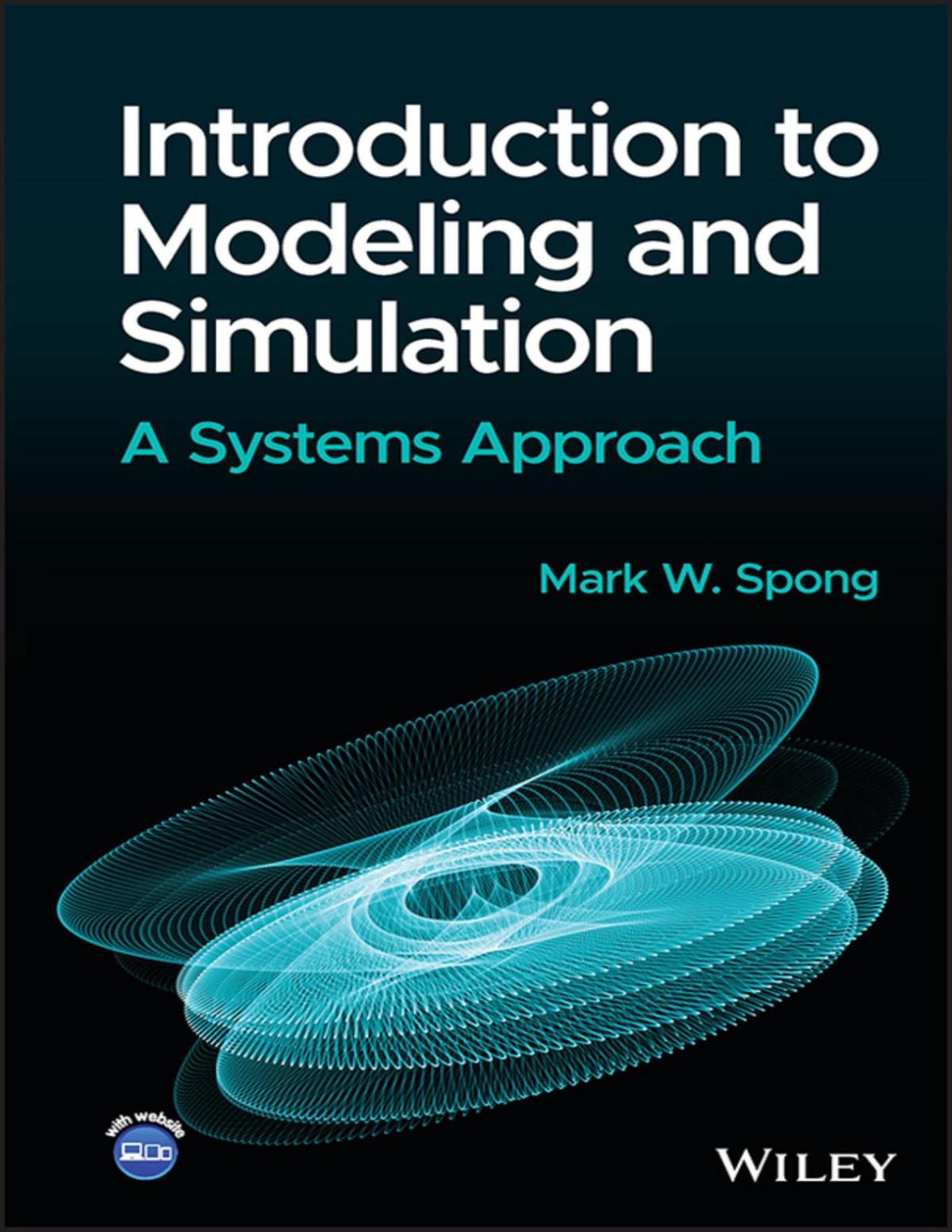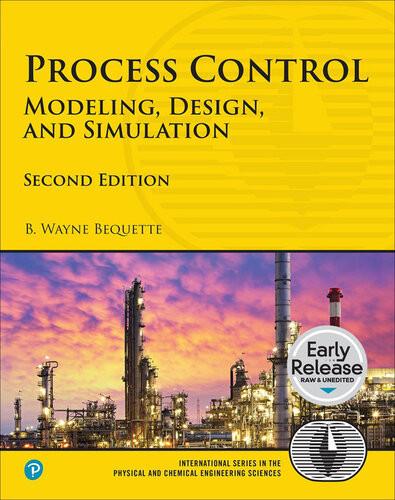StatisticalMechanics: TheoryandMolecular Simulation
SECONDEDITION
MARKE.TUCKERMAN
DepartmentofChemistryandCourantInstituteofMathematicalSciences
NewYorkUniversity
GreatClarendonStreet,Oxford,OX26DP, UnitedKingdom
OxfordUniversityPressisadepartmentoftheUniversityofOxford. ItfurtherstheUniversity’sobjectiveofexcellenceinresearch,scholarship, andeducationbypublishingworldwide.Oxfordisaregisteredtrademarkof OxfordUniversityPressintheUKandincertainothercountries ©MarkE.Tuckerman2023
Themoralrightsoftheauthorhavebeenasserted
FirstEditionpublishedin2010
SecondEditionpublishedin2023
Allrightsreserved.Nopartofthispublicationmaybereproduced,storedin aretrievalsystem,ortransmitted,inanyformorbyanymeans,withoutthe priorpermissioninwritingofOxfordUniversityPress,orasexpresslypermitted bylaw,bylicenceorundertermsagreedwiththeappropriatereprographics rightsorganization.Enquiriesconcerningreproductionoutsidethescopeofthe aboveshouldbesenttotheRightsDepartment,OxfordUniversityPress,atthe addressabove
Youmustnotcirculatethisworkinanyotherform andyoumustimposethissameconditiononanyacquirer
PublishedintheUnitedStatesofAmericabyOxfordUniversityPress 198MadisonAvenue,NewYork,NY10016,UnitedStatesofAmerica
BritishLibraryCataloguinginPublicationData Dataavailable
LibraryofCongressControlNumber:2023930434
ISBN978–0–19–882556–2
DOI:10.1093/oso/9780198825562.001.0001
Printedandboundby
CPIGroup(UK)Ltd,Croydon,CR04YY LinkstothirdpartywebsitesareprovidedbyOxfordingoodfaithand forinformationonly.Oxforddisclaimsanyresponsibilityforthematerials containedinanythirdpartywebsitereferencedinthiswork.
ToJocelynandallmygroupmembers,past,present,andyettojoin
Preface
Thefieldofstatisticalmechanicsisevolvingwithstunningrapidity.Practitionersare activelydevelopingtheoreticalandcomputationaltoolsforsolving complexproblems andthosetoolsarebeingdeployedinincreasinglynovelapplicationstorealsystems ofphysical,chemical,biological,andengineeringimport.Thefirsteditionofthisbook providedasolidfoundationinthetheoreticalunderpinningsandcomputationaltechnologiesthatallowtheclassicalandquantumstatisticalmechanicsofparticlestobe formallyunderstoodandpracticallyimplemented.Thesecoreconceptswillforever remaincentraltothefieldandindispensablelearningforanyonewishingtoenterit. However,theinterveningten-plusyearshavewitnessedadvancesofsuchsignificance thatIfeltaneweditionofthebookwasneededtoincorporatethesedevelopmentsinto thebook’sframework.Theseincorporationsandrevisionscaused thebook’slengthto swellbyover150additionalpages.
Inthelastdecade,theapplicationofmodelsandmethodsfromthesubareaof artificialintelligenceknownas machinelearning hastransformedthelandscapeof computationalstatisticalmechanics.Large-scalecomputersimulationsinstatistical mechanicsoftengenerateoutputdatasetsofsuchenormityand heterogeneitythat theycouldberegardedas“bigdata”withina“chemical”scope(broadlyspeaking). Thesedatasetsoftenrepresentmultiplesystemscontainingheterogeneousenvironmentsevolvingunderavarietyofexternalconditions.Thetechniquesofmachine learningallowthesedatasetstobeminedforhiddenpatterns,patternsthatcanbe furtherleveragedtoconstructsimplifiedmodelsofthedata.Owing totheirlowcomputationaloverhead,thesemodelscanbeemployedinsubsequent simulationsthat reachlongerlengthandtimescales,revealmeaningfulreactioncoordinatesforspecificprocesses,andevendriverare-eventsimulationsleadingtohighlyfeaturedfreeenergyhypersurfaces.Becausemachinelearninghasbecomesuchanimpactfultool instatisticalmechanics,asubstantialnewchapter(Chapter17) hasbeenaddedthat introducesbasicmachinelearningconceptsandmodeltypes,includingkernel-ridge methods,support-vectormachines,neuralnetworks,weighted-neighbormodels,and data-clusteringalgorithms,anddemonstratestheapplicationofthesemodels,inboth regressionandclassificationmodes,instatisticalmechanicalsimulationproblems. Otherimportantdevelopmentshaveshapedthesecondeditionsignificantly.The discussionsofcollectivevariablesandfree-energybasedrare-eventsamplingtechniques inChapter8havebeenoverhauledtocapturetheimpressiveinnovationsinthesemethodsandtohighlighthownoveltechniquessuchaswell-temperedmetadynamicsand drivenadiabaticfree-energydynamicsareconnectedandcanbesynergisticallycombined,bothwitheachotherandwithsimplermethodslikeumbrellasampling.The treatmentofFeynmanpathintegralsinChapter12hasbeenenhancedtoclarifythe meaningofimaginarytime,toincludemethodsforsimulatingsystemsof N identical
viii Preface
bosonsandfermionsviapathintegralsandtoincorporateaneleganttechniquefor reducingthecomputationaloverheadofpathintegralsimulations.Thediscussionof approachesforapproximatingquantumtimecorrelationfunctions inChapter14has beenaugmentedtoincludeaformallyexactopen-chainformulation. Functionalsalso makeamoreprominentappearanceinthesecondedition,beingused toconstructa classicalentropymaximizationprincipleinChapters4through6toderiveensemble distributions,andanadditionalappendixonthecalculusoffunctionshasalsobeen provided.ProofsoftheHendersonTheoremonradialdistribution functionsandthe PotentialDistributionTheoremonexcesschemicalpotentialscanbefoundinthese chaptersaswell.Resonancesinmultipletime-scaleintegrationaredealtwithinmuch greaterdepthinChapters4and15andalgorithmsforcircumventingthesenumericalartifactsandallowingverylargetimestepsinmoleculardynamicssimulations arepresented.Otheraddedmaterialincludesanexpandeddiscussionofnumerical integratorsfordeterministicandstochasticthermostatsinmoleculardynamics,more exactlysolvablemodelsandnumericalapplications,resonance-freemultipletime-scale algorithms,andmoreend-of-chapterexercises.Theoverallstructureofthebookhas notbeenchangedfromthefirstedition:equilibriumclassicalstatisticalmechanics precedesequilibriumquantumstatisticalmechanics,andbothprecedediscussionsof classicalandquantumtime-dependentstatisticalmechanics.Stochasticdynamics,discretemodels,andmachinelearningmakeupthefinalthreechaptersofthebook.Asin theoriginaledition,computationalmethodsarepresentedside-by-sidewiththetheoreticaldevelopments,and,totheextentpossible,mathematical complexitygradually increaseswithineachchapter.
AsIdidinthefirstedition,Iwishtoclosethisprefacewithalistofacknowledgments.Iam,asever,trulygratefultoalloftheteachers,mentors,colleagues,and coworkersacknowledgedinthefirstedition’spreface,whichwillimmediatelyfollow.In addition,contentforthesecondeditionwouldnothavebeenpossiblewithouthighly fruitfulcollaborationswithBenedictLeimkuhler,CharllesAbreu,JuttaRogal,Ondrej Marsalek,SerdalKirmizialtin,andJosephCendagorta.ImustalsoexpressmycontinuedthankstotheNationalScienceFoundation,theU.S.DepartmentofEnergy,and theArmyResearchOfficefortheongoingsupportIhavereceivedfromtheseagencies. Finally,Iowe,onceagain,atremendousdebtofgratitudetomywife JocelynLeka wholentmeherconsiderabletalentsasasubstantiveeditor.Aswith thefirstedition, herskillswereemployedonlyforthetextualpartsofthebook;any mathematical errorsremainmineandminealone.
M.E.T. NewYork December,2022
Statisticalmechanicsisatheoreticalframeworkthataimstopredicttheobservable staticanddynamicpropertiesofamany-bodysystemstartingfromitsmicroscopic constituentsandtheirinteractions.Itsscopeisasbroadasthesetof“many-body” systemsislarge:aslongasthereexistsarulegoverningthebehaviorofthefundamentalobjectsthatcomprisethesystem,themachineryofstatisticalmechanics canbeapplied.Consequently,statisticalmechanicshasfoundapplicationsoutsideof physics,chemistry,andengineering,includingbiology,socialsciences,economics,and appliedmathematics.Becauseitseekstoestablishabridgebetween themicroscopic andmacroscopicrealms,statisticalmechanicsoftenprovidesameansofrationalizing observedpropertiesofasystemintermsofthedetailed“modesof motion”ofitsbasic constituents.Anexamplefromphysicalchemistryisthesurprisinglyhighdiffusion constantofanexcessprotoninbulkwater,whichisasinglemeasurablenumber. However,thissinglenumberbeliesastrikinglycomplexdanceofhydrogenbondrearrangementsandchemicalreactionsthatmustoccuratthelevelofindividualor smallclustersofwatermoleculesinorderforthispropertytoemerge.Inthephysical sciences,thetechnologyofmolecularsimulation,whereinasystem’s microscopicinteractionrulesareimplementednumericallyonacomputer,allowsuch “mechanisms” tobeextractedand,throughthemachineryofstatisticalmechanics,predictionsof macroscopicobservablestobegenerated.Inshort,molecularsimulationisthecomputationalrealizationofstatisticalmechanics.Thegoalofthisbook,therefore,isto synthesizethesetwoaspectsofstatisticalmechanics:theunderlyingtheoryofthe subject,inbothitsclassicalandquantumdevelopments,andthepracticalnumerical techniquesbywhichthetheoryisappliedtosolverealisticproblems.
Thisbookisaimedprimarilyatgraduatestudentsinchemistryorcomputational biologyandgraduateoradvancedundergraduatestudentsinphysicsorengineering. Thesestudentsareincreasinglyfindingthemselvesengagedinresearchactivitiesthat crosstraditionaldisciplinarylines.Successfuloutcomesforsuch projectsoftenhinge ontheirabilitytotranslatecomplexphenomenaintosimplemodelsanddevelopapproachesforsolvingthesemodels.Becauseofitsbroadscope,statisticalmechanics playsafundamentalroleinthistypeofworkandisanimportantpart ofastudent’s toolbox.
ThetheoreticalpartofthebookisanextensiveelaborationoflecturenotesIdevelopedforagraduate-levelcourseinstatisticalmechanicsIgiveat NewYorkUniversity. Thesecoursesareprincipallyattendedbygraduateandadvanced undergraduatestudentswhoareplanningtoengageinresearchintheoreticalandexperimentalphysical chemistryandcomputationalbiology.Themostdifficultquestionfacedbyanyone wishingtodesignalecturecourseorabookonstatisticalmechanics iswhattoincludeandwhattoomit.Becausestatisticalmechanicsisanactivefieldofresearch,it comprisesatremendousbodyofknowledge,anditissimplyimpossibletotreatthe entiretyofthesubjectinasingleopus.Forthisreason,manybookswiththewords “statisticalmechanics”intheirtitlescandifferconsiderably.Here, Ihaveattempted tobringtogethertopicsthatreflectwhatIseeasthemodernlandscapeofstatisticalmechanics.Thereaderwillnoticefromaquickscanofthetableofcontentsthat
x Preface
thetopicsselectedarerarelyfoundtogetherinindividualtextbooksonthesubject; thesetopicsincludeisobaricensembles,pathintegrals,classicalandquantumtimedependentstatisticalmechanics,thegeneralizedLangevinequation,theIsingmodel, andcriticalphenomena.(TheclosestsuchbookIhavefoundisalso oneofmyfavorites, DavidChandler’s IntroductiontoModernStatisticalMechanics.)
Thecomputationalpartofthebookjoinssynergisticallywiththetheoreticalpart andisdesignedtogivethereaderasolidgroundinginthemethodology employedto solveproblemsinstatisticalmechanics.Itisintendedneitherasasimulationrecipe booknorascientificprogrammer’sguide.Rather,itaimstoshowhow thedevelopmentofcomputationalalgorithmsderivesfromtheunderlyingtheorywiththehope ofenablingreaderstounderstandthemethodology-orientedliteratureanddevelop newtechniquesoftheirown.ThefocusisonthemoleculardynamicsandMonte Carlotechniquesandthemanynovelextensionsofthesemethods thathaveenhanced theirapplicabilityto,forexample,largebiomolecularsystems,complexmaterials, andquantumphenomena.Mostofthetechniquesdescribedarewidelyavailablein molecularsimulationsoftwarepackagesandareroutinelyemployedin computational investigations.Aswiththetheoreticalcomponent,itwasnecessarytoselectamongthe numerousimportantmethodologicaldevelopmentsthathaveappearedsincemolecularsimulationwasfirstintroduced.Unfortunately,severalimportanttopicshadtobe omittedduetospaceconstraints,includingconfiguration-biasMonteCarlo,thereferencepotentialspatialwarpingalgorithm,andsemi-classicalmethodsforquantum timecorrelationfunctions.ThisomissionwasnotmadebecauseIview thesemethods aslessimportantthanthoseIincluded.Rather,Iconsiderthesetobeverypowerful buthighlyadvancedmethodsthat,individually,mighthaveanarrowertargetaudience.Infact,thesetopicswereslatedtoappearinachapteroftheirown.However, asthebookevolved,Ifoundthatnearly700pageswereneededto laythefoundation Isought.
Inorganizingthebook,Ihavemadeseveralstrategicdecisions.First,thebookis structuredsuchthatconceptsarefirstintroducedwithintheframeworkofclassical mechanicsfollowedbytheirquantummechanicalcounterparts.Thisliescloserperhaps toaphysicist’sperspectivethan,forexample,thatofachemist,butIfindittobea particularlynaturalone.Moreover,givenhowwidespreadcomputationalstudiesbased onclassicalmechanicshavebecomecomparedtoanalogousquantuminvestigations (whichhaveconsiderablyhighercomputationaloverhead),thisprogressionseemsto bebothlogicalandpractical.Second,thetechnicaldevelopmentwithineachchapter isgraduated,withthelevelofmathematicaldetailgenerallyincreasingfromchapter starttochapterend.Thus,themathematicallymostcomplextopicsarereserved forthefinalsectionsofeachchapter.Iassumethatreadershaveanunderstandingof calculus(throughcalculusofseveralvariables),linearalgebra,andordinarydifferential equations.Thisstructurehopefullyallowsreaderstomaximizewhat theytakeaway fromeachchapterwhilerenderingiteasiertofindastoppingpointwithineachchapter. Inshort,thebookisstructuredsuchthatevenapartialreading ofachapterallows thereadertogainabasicunderstandingofthesubject.Itshould benotedthatI attemptedtoadheretothisgraduatedstructureonlyasageneralprotocol.WhereI feltthatbreakingthisprogressionmadelogicalsense,Ihaveforewarnedthereader
Preface xi aboutthemathematicalargumentstofollow,andthefinalresultis generallygivenat theoutset.Readerswishingtoskipthemathematicaldetailscando sowithoutloss ofcontinuity.
ThethirddecisionIhavemadeistointegratetheoryandcomputationalmethods withineachchapter.Thus,forexample,thetheoryoftheclassicalmicrocanonical ensembleispresentedtogetherwithadetailedintroductiontothemoleculardynamics methodandhowthelatterisusedtogenerateaclassicalmicrocanonicaldistribution. TheotherclassicalensemblesarepresentedinasimilarfashionasistheFeynman pathintegralformulationofquantumstatisticalmechanics.Theintegrationoftheory andmethodologyservestoemphasizetheviewpointthatunderstandingonehelpsin understandingtheother.
Throughoutthebook,manyofthecomputationalmethodspresentedareaccompaniedbysimplenumericalexamplesthatdemonstratetheirperformance.Theseexamplesrangefromlow-dimensional“toy”problemsthatcanbeeasily codedupbythe reader(someoftheexercisesineachchapteraskpreciselythis)toatomicandmolecularliquids,aqueoussolutions,modelpolymers,biomolecules,andmaterials.Notevery methodpresentedisaccompaniedbyanumericalexample,andingeneralIhavetried nottooverwhelmthereaderwithaplethoraofapplicationsrequiring detailedexplanationsoftheunderlyingphysics,asthisisnottheprimaryaimofthe book.Once thebasicsofthemethodologyareunderstood,readerswishingto exploreapplications particulartotheirinterestsinmoredepthcansubsequentlyrefer totheliterature.
Awordortwoshouldbesaidabouttheproblemsetsattheendofeachchapter. Mathandsciencearenotspectatorsports,andtheonlywaytolearnthematerialis tosolveproblems.Someoftheproblemsinthebookrequirethereadertothinkconceptuallywhileothersaremoremathematical,challengingthereader toworkthrough variousderivations.Therearealsoproblemsthataskthereadertoanalyzeproposed computationalalgorithmsbyinvestigatingtheircapabilities.Forreaderswithsome programmingbackground,thereareexercisesthatinvolvecoding upamethodfora simpleexampleinordertoexplorethemethod’sperformanceonthat example,and insomecases,reproduceafigurefromthetext.Thesecodingexercisesareincluded becauseonecanonlytrulyunderstandamethodbyprogrammingitupandtrying itoutonasimpleproblemforwhichlongrunscanbeperformedandmanydifferent parameterchoicescanbestudied.However,Imustemphasizethatevenifamethod workswellonasimpleproblem,itisnotguaranteedtoworkwellforrealisticsystems. Readersshouldnot,therefore,na¨ıvelyextrapolatetheperformanceofanymethodthey tryonatoysystemtohigh-dimensionalcomplexproblems.Finally,ineachproblem set,someproblemsareprecededbyanasterisk(∗).Theseareproblemsofamorechallengingnaturethatrequiredeeperthinkingoramorein-depthmathematicalanalysis. Alloftheproblemsaredesignedtostrengthenunderstandingofthebasicideas.
Letmeclosethisprefacebyacknowledgingmyteachers,mentors, colleagues,and coworkerswithoutwhomthisbookwouldnothavebeenpossible.Itookmyfirst statisticalmechanicscourseswithY.R.ShenattheUniversityofCaliforniaBerkeley andA.M.M.PruiskenatColumbiaUniversity.Later,IauditedthecourseteamtaughtbyJamesL.SkinnerandBruceJ.Berne,alsoatColumbia.Iwasalsoprivileged tohavebeenmentoredbyBruceBerneasagraduatestudent,by MicheleParrinello
duringapostdoctoralappointmentattheIBMForschungslaboratoriuminR¨uschlikon, Switzerland,andbyMichaelL.KleinwhileIwasaNationalScienceFoundation postdoctoralfellowattheUniversityofPennsylvania.Underthementorshipofthese extraordinaryindividuals,Ilearnedanddevelopedmanyofthecomputationalmethods thatarediscussedinthebook.ImustalsoexpressmythankstotheNationalScience Foundationfortheircontinuedsupportofmyresearchoverthepastdecade.Manyof thedevelopmentspresentedhereweremadepossiblethroughthe grantsIreceivedfrom them.IamdeeplygratefultotheAlexandervonHumboldtFoundationforaFriedrich WilhelmBesselResearchAwardthatfundedanextendedstayinGermanywhereIwas abletoworkonideasthatinfluencedmanypartsofthebook.Iamequallygrateful tomyGermanhostandfriendDominikMarxforhissupportduringthis stay,for manyusefuldiscussions,andformanyfruitfulcollaborationsthathavehelpedshape thebook’scontent.Ialsowishtoacknowledgemylong-timecollaboratorandfriend GlennMartynaforhishelpincraftingthebookinitsinitialstagesandforhiscritical readingofthefirstfewchapters.Ihavealsoreceivedmanyhelpfulsuggestionsfrom BruceBerne,GiovanniCiccotti,Hae-SooOh,MichaelShirts,andDubravkoSabo.I amindebtedtotheexcellentstudentsandpostdocswithwhomIhaveworkedoverthe yearsfortheirinvaluablecontributionstoseveralofthetechniquespresentedherein andforalltheyhavetaughtme.Iwouldalsoliketoacknowledgemyformerstudent KirynHaslingerHoffmanforherworkontheillustrationsusedintheearlychapters. Finally,IoweatremendousdebtofgratitudetomywifeJocelynLeka,whosefinely honedskillsasaneditorwerebroughttobearoncraftingthewordingusedthroughout thebook.Editingmetookupmanyhoursofhertime.Herskillswererestrictedto thetextualpartsofthebook;shewasnotchargedwiththeoneroustaskofediting theequations.Consequently,anyerrorsinthelatteraremineand minealone.
M.E.T. NewYork July,2010
1Classicalmechanics
1.3Phasespace:visualizingclassicalmotion5
1.4Lagrangianformulationofclassicalmechanics:Ageneral frameworkforNewton’slaws 10 1.5Legendretransforms 17
1.6GeneralizedmomentaandtheHamiltonianformulationof classicalmechanics 18
1.7Asimpleclassicalpolymermodel
1.8Theactionintegral
2Theoreticalfoundationsofclassicalstatisticalmechanics
2.4Phase-spacevolumesandLiouville’stheorem65
2.5TheensembledistributionfunctionandtheLiouvilleequation67
3Themicrocanonicalensembleandintroductiontomolecular dynamics 77 3.1Briefoverview 77
3.2Basicthermodynamics,Boltzmann’srelation,andthe partitionfunctionofthemicrocanonicalensemble78
3.3Theclassicalvirialtheorem
3.4Conditionsforthermalequilibrium
3.6Theharmonicoscillatorandharmonicbaths95
3.7Introductiontomoleculardynamics
3.8Integratingtheequationsofmotion:Finitedifferencemethods101
3.9Systemssubjecttoholonomicconstraints106
3.10Theclassicaltimeevolutionoperatorandnumericalintegrators110
3.11Multipletime-scaleintegration 116
xiv Contents
3.12Symplecticintegrationforquaternions122
3.13Exactlyconservedtime-stepdependentHamiltonians124
3.14Illustrativeexamplesofmoleculardynamicscalculations127
3.15Problems 134
4Thecanonicalensemble 139
4.1Introduction:Adifferentsetofexperimentalconditions139
4.2Thermodynamicsofthecanonicalensemble140
4.3Thecanonicalphase-spacedistributionandpartitionfunction141
4.4Canonicalensembleviaentropymaximization146
4.5Energyfluctuationsinthecanonicalensemble148
4.6Simpleexamplesinthecanonicalensemble150
4.7Structureandthermodynamicsinrealgasesandliquidsfrom spatialdistributionfunctions 159
4.8PerturbationtheoryandthevanderWaalsequation176
4.9Moleculardynamicsinthecanonicalensemble:Hamiltonian formulationinanextendedphasespace186
4.10Classicalnon-Hamiltonianstatisticalmechanics191
4.11Nos´e-Hooverchains 198
4.12IntegratingtheNos´e-Hooverchainequations203
4.13Theisokineticensemble:Avariantofthecanonicalensemble210
4.14IsokineticNos´e-Hooverchains:Achievingverylargetimesteps214
4.15Applyingcanonicalmoleculardynamics:Liquidstructure218
4.16Problems 220
5Theisobaricensembles 231
5.1Whyconstantpressure?
5.2Thermodynamicsofisobaricensembles232
5.3Isobaricphase-spacedistributionsandpartitionfunctions233
5.4Isothermal-isobaricensembleviaentropymaximization239
5.5Pressureandworkvirialtheorems 240
5.6Anidealgasintheisothermal-isobaricensemble242
5.7Extendingtheisothermal-isobaricensemble:Anisotropiccell fluctuations 243
5.8Derivationofthepressuretensorestimatorfromthecanonical partitionfunction 247
5.9Moleculardynamicsintheisoenthalpic-isobaricensemble251
5.10Moleculardynamicsintheisothermal-isobaricensembleI: Isotropicvolumefluctuations 254
5.11Moleculardynamicsintheisothermal-isobaricensembleII: Anisotropiccellfluctuations 258
5.12Atomicandmolecularvirials 261
5.13IntegratingtheMartyna-Tobias-Kleinequationsofmotion263
5.14Theisothermal-isobaricensemblewithconstraints: TheROLLalgorithm
5.15Problems
6Thegrandcanonicalensemble
6.1Introduction:Theneedforyetanotherensemble281
6.2Euler’stheorem
6.3Thermodynamicsofthegrandcanonicalensemble283
6.4Grandcanonicalphasespaceandthepartitionfunction284
6.5Grandcanonicalensembleviaentropymaximization290
6.6Illustrationofthegrandcanonicalensemble:Theidealgas291
6.7Particlenumberfluctuationsinthegrandcanonicalensemble293
6.8Potentialdistributiontheorem
6.9Moleculardynamicsinthegrandcanonicalensemble297
7.1IntroductiontotheMonteCarlomethod303
7.2TheCentralLimittheorem
7.4HybridMonteCarlo
7.5ReplicaexchangeMonteCarlo
7.6Wang-Landausampling
7.7Transitionpathsamplingandthetransitionpathensemble328
7.8Problems
8.1Free-energyperturbationtheory
8.2Adiabaticswitchingandthermodynamicintegration342
8.3Adiabaticfree-energydynamics
8.4Jarzynski’sequalityandnonequilibriummethods350
8.5Theproblemofrareevents
8.6Collectivevariables
8.7Thebluemoonensembleapproach
8.8Umbrellasamplingandweightedhistogrammethods370
8.9Wang-Landausampling
8.10Drivenadiabaticfree-energydynamics374
8.11Metadynamics
8.12Thecommittordistributionandthehistogramtest390
8.13Problems
9.1Introduction:Wavesandparticles
9.2Reviewofthefundamentalpostulatesofquantummechanics399 9.3Simpleexamples
9.4Identicalparticlesinquantummechanics:Spinstatistics419
9.5Problems
10Quantumensemblesandthedensitymatrix
10.1Thedifficultyofmany-bodyquantummechanics430 10.2Theensembledensitymatrix
xvi Contents
10.3Timeevolutionofthedensitymatrix434
11Quantumidealgases:Fermi-DiracandBose-Einsteinstatistics
11.1Complexitywithoutinteractions
11.2Generalformulationofthequantum-mechanicalidealgas446
11.3Anidealgasofdistinguishablequantumparticles450
11.4Generalformulationforfermionsandbosons451
11.5Theidealfermiongas
11.6Theidealbosongas
12TheFeynmanpathintegral 486
12.1Quantummechanicsasasumoverpaths486
12.2Derivationofpathintegralsforthecanonicaldensitymatrix andthetimeevolutionoperator 490
12.3Thermodynamicsandexpectationvaluesfrompathintegrals497
12.4Thecontinuouslimit:Functionalintegrals502
12.5Howtothinkaboutimaginarytimepropagation511
12.6Many-bodypathintegrals 513
12.7Quantumfree-energyprofiles 522
12.8Numericalevaluationofpathintegrals524 12.9Problems 554
13Classicaltime-dependentstatisticalmechanics 560
13.1Ensemblesofdrivensystems 560
13.2Drivensystemsandlinearresponsetheory562
13.3Applyinglinearresponsetheory:Green-Kuborelationsfortransportcoefficients 569
13.4Calculatingtimecorrelationfunctionsfrommoleculardynamics579
13.5Thenonequilibriummoleculardynamicsapproach583 13.6Problems 594
14Quantumtime-dependentstatisticalmechanics 599
14.1Time-dependentsystemsinquantummechanics599
14.2Time-dependentperturbationtheoryinquantummechanics603
14.3Timecorrelationfunctionsandfrequencyspectra613
14.4Examplesoffrequencyspectra 617
14.5Quantumlinearresponsetheory 620
14.6Approximationstoquantumtimecorrelationfunctions626 14.7Problems 641
15TheLangevinandgeneralizedLangevinequations 646
15.1Thegeneralmodelofasystemplusabath646
15.2DerivationofthegeneralizedLangevinequation649
15.3Analyticallysolvableexamples 656
15.4Vibrationaldephasingandenergyrelaxationinsimplefluids664
15.5MoleculardynamicswiththeLangevinequation667
15.6Designingmemorykernelsforspecifictasks676
15.7Samplingstochastictransitionpaths680
15.8Mori-Zwanzigtheory
16.1Phasetransitionsandcriticalpoints695
16.2Thecriticalexponents α, β, γ,and δ
16.3MagneticsystemsandtheIsingmodel698
16.7Isingmodelintwodimensions
16.8Spincorrelationsandtheircriticalexponents719
16.9Introductiontotherenormalizationgroup720
16.10Fixedpointsoftherenormalizationgroupequationsin greaterthanonedimension
16.11Generallinearizedrenormalizationgrouptheory729
16.12Understandinguniversalityfromthelinearized
17.1Machinelearninginstatisticalmechanics:Whatandwhy?740
17.2Threekeyprobabilitydistributions741
17.3Simplelinearregressionasacasestudy743
17.4Kernelmethods
17.9Intrinsicdimensionofadatamanifold784
Classicalmechanics
1.1Introduction
Thefirstpartofthisbookisdevotedtothesubjectofclassicalstatisticalmechanics,whichisfoundeduponthefundamentallawsofclassicalmechanicsasoriginally statedbyNewton.Althoughthelawsofclassicalmechanicswerefirstpostulatedto studythemotionofplanets,starsandotherlarge-scaleobjects,theyturnouttobe asurprisinglygoodapproximationatthemolecularlevel(wherethetruebehavioris correctlydescribedbythelawsofquantummechanics).Indeed,anentirecomputationalmethodology,knownas moleculardynamics,isbasedontheapplicabilityofthe lawsofclassicalmechanicstomicroscopicsystems.Moleculardynamicshasbeenremarkablysuccessfulinitsabilitytopredictmacroscopicthermodynamicanddynamic observablesforawidevarietyofsystemsusingtherulesofclassicalstatisticalmechanicstobediscussedinthenextchapter.Manyoftheseapplicationsaddressimportant problemsinbiology,suchasproteinandnucleicacidfolding,inmaterials science,such assurfacecatalysisandfunctionalization,inthestructureanddynamicsofglassesand theirmelts,andinnanotechnology,suchasthebehaviorofself-assembledmonolayers andtheformationofmoleculardevices.Throughoutthebook,wewillbediscussing bothmodelandrealisticexamplesofsuchapplications.
Inthischapter,wewillbeginwithadiscussionofNewton’slawsofmotionand builduptothemoreelegantLagrangianandHamiltonianformulationsofclassical mechanics,bothofwhichplayfundamentalrolesinstatisticalmechanics.Theorigin oftheseformulationsfromtheactionprinciplewillbediscussed.The chapterwill concludewithafirstlookatsystemsthatdonotfitintotheHamiltonian/Lagrangian frameworkandtheapplicationofsuchsystemsinthedescriptionof certainphysical situations.
1.2Newton’slawsofmotion
In1687,theEnglishphysicistandmathematicianSirIsaacNewtonpublishedthe PhilosophiaeNaturalisPrincipiaMathematica,whereinthreesimpleandelegantlaws governingthemotionofinteractingobjectsaregiven.Thesemaybestatedbrieflyas follows:
1.Intheabsenceofexternalforces,abodywilleitherbeatrest orexecutemotion alongastraightlinewithaconstantvelocity v
2.Theactionofanexternalforce F onabodyproducesanacceleration a equalto theforcedividedbythemass m ofthebody:
3.IfbodyAexertsaforceonbodyB,thenbodyBexertsanequal andopposite forceonbodyA.Thatis,if FAB istheforcebodyAexertsonbodyB,thenthe force FBA exertedbybodyBonbodyAsatisfies
Ingeneral,twoobjectscanexertattractiveorrepulsiveforces oneachother,depending ontheirrelativespatiallocation,andtheprecisedependenceoftheforceontherelative locationoftheobjectsisspecifiedbyaparticular forcelaw. 1
AlthoughNewton’sinterestslargelyfocusedonthemotionofcelestialbodiesinteractingviagravitationalforces,mostatomsaremassiveenoughthattheirmotion canbetreatedreasonablyaccuratelywithinaclassicalframework.Hence,thelaws ofclassicalmechanicscanbeapproximatelyappliedatthemolecularlevel.Naturally, therearenumerousinstancesinwhichtheclassicalapproximationbreaksdown,and aproperquantummechanicaltreatmentisneeded.Forthepresent,however,wewill assumetheapproximatevalidityofclassicalmechanicsatthemolecularleveland proceedtoapplyNewton’slawsasstatedabove.
ThemotionofanobjectcanbedescribedquantitativelybyspecifyingtheCartesianpositionvector r(t)oftheobjectinspaceatanytime t.Thisistantamountto specifyingthreefunctionsoftime,thecomponentsof r(t),
Recognizingthatthevelocity v(t)oftheobjectisthefirsttimederivativeofthe position, v(t)=dr/dt,andthattheacceleration a(t)isthefirsttimederivativeofthe velocity, a(t)=dv/dt,theaccelerationiseasilyseentobethesecondderivativeof position, a(t)=d2r/dt2.Therefore,Newton’ssecondlaw, F = ma,canbeexpressed asasecond-orderdifferentialequation
d2r
t2 = F.
(Weshallhenceforthemploytheoverdotnotationfordifferentiationwithrespectto time.Thus, r =dr/dt and r =d2r/dt2.)Sinceeqn.(1.2.4)isasecond-orderequation, itisnecessarytospecifytwoinitialconditions,thesebeingtheinitial position r(0) andinitialvelocity v(0).Thesolutionofeqn.(1.2.4)subjecttotheseinitialconditions uniquelyspecifiesthemotionoftheobjectforalltime.
Theforce F thatactsonanobjectiscapableofdoing work ontheobject.Inorder toseehowworkiscomputed,considerFig.1.1,whichshowsaforce F actingona
1Throughoutthebook,vectorquantitieswillbedesignatedusingboldfacetype.Thus,inthree spatialdimensions,avector u hasthreecomponents ux, uy,and uz,andwewillrepresentthevector astheorderedtriple u =(ux,uy,uz).Thevectormagnitude u = |u| = u2 x + u2 y + u2 z willbe denotedusingnormaltype.
Fig.1.1 Exampleofmechanicalwork.HeredW = F dl = F cos θdl systemalongaparticularpath.TheworkdW performedalongashortsegmentdl of thepathisdefinedtobe
ThetotalworkdoneontheobjectbytheforcebetweenpointsAandBalongthe pathisobtainedbyintegratingoverthepathfromAtoB:
Ingeneral,theworkdoneonanobjectbyaforcedependsonthepathtakenbetweenA andB.Forcertaintypesofforces,called conservativeforces,theworkisindependent ofthepathandonlydependsontheendpointsofthepath.Weshall describeshortly howconservativeforcesaredefined.
Notethatthedefinitionofworkdependsoncontext.Equation(1.2.6)specifiesthe workdone by aforce F.Ifthisforceisanintrinsicpartofthesystem,thenwereferto thistypeofworkasworkdone bythesystem.Ifwewishtocalculatetheworkdone against suchaforcebysomeexternalagent,thenthisworkwouldbethe negative of thatobtainedusingeqn.(1.2.6),andwerefertothisasworkdone onthesystem.An exampleistheforceexertedbytheEarth’sgravitationalfieldonan objectofmass m. IfthemassfallsundertheEarth’sgravitationalpullthroughadistance h,wecanthink oftheobjectandthegravitationalforceasdefiningthemechanicalsystem.Inthis case,thesystemdoeswork,andeqn.(1.2.6)wouldyieldapositivevalue.Conversely, ifweappliedeqn.(1.2.6)totheoppositeproblemofraisingtheobject toaheight h, itwouldyieldanegativeresult.Thisissimplytellingussomeexternalagentmust dowork on thesystemagainsttheforceofgravityinordertoraiseittoaheight h. Generally,itisobviouswhatsigntoimparttowork,yetthedistinction betweenwork doneonandbyasystemwillbecomeimportantinourdiscussionsofthermodynamics andclassicalstatisticalmechanicsinChapters2through6.
GiventheformofNewton’ssecondlawineqn.(1.2.4),itcanbeeasilyshownthat, inaflatorEuclideanspace,Newton’sfirstlawisredundant.AccordingtoNewton’s firstlaw,anobjectinitiallyataposition r(0)movingwithconstantvelocity v will movealongastraightlinedescribedby
r(t)= r(0)+ vt.
(1.2.7)
Thisisanexampleofa trajectory,thatis,aspecificationoftheobject’spositionasa functionoftimeandinitialconditions.Ifnoforceactsontheobject,then,according toNewton’ssecondlaw,itspositionwillbethesolutionof
Thestraightlinemotionofeqn.(1.2.7)is,infact,theuniquesolutionofeqn.(1.2.8) foranobjectwhoseinitialpositionis r(0)andwhoseinitial(andconstant)velocityis v.Thus,Newton’ssecondlawembodiesNewton’sfirstlaw.
Statisticalmechanicsisconcernedwiththebehavioroflargenumbersofobjects thatcanbeviewedasthefundamentalconstituentsofaparticularmicroscopicmodel ofthesystem,whethertheyareindividualatomsormolecules,orevengroupsofatoms inamacromolecule(forexample,theaminoacidsinaprotein).Weshall, henceforth, refertotheseconstituentsas“particles”(or,insomecases,“pseudoparticles”).The classicalbehaviorofasystemof N particlesinthreedimensionsisgivenbythegeneralizationofNewton’ssecondlawtothesystem.Inordertodevelopthegeneralform ofNewton’ssecondlaw,notethatparticle i,i ∈ [1,N ], willexperienceaforce Fi due toalloftheotherparticlesinthesystemandpossiblytheexternal environmentorexternalagentsaswell.Denotingthepositionvectorsofthe N particlesas r1,..., rN ,the forces Fi aregenerallyfunctionsofthesepositions,andiffrictionalforces arepresent, Fi couldalsobeafunctionoftheparticle’svelocity ri.Wedenotethisfunctional dependenceas Fi = Fi(r1,..., rN , ri).Forexample,iftheforce Fi dependsonlyon individualcontributionsfromeveryotherparticleinthesystem,we saythattheforces are pairwiseadditive.Inthiscase,theforce Fi canbeexpressedas
Thefirsttermineqn.(1.2.9)describesforcesthatareintrinsictothesystemandare partofthedefinitionofthemechanicalsystem,whilethesecondtermdescribesforces thatareentirelyexternaltothesystem.Forageneral N -particlesystem,Newton’s secondlawforparticle i takestheform
iri = Fi(r1,...,
Theseequations,referredtoasthe equationsofmotion ofthesystem,mustbesolved subjecttoasetofinitialpositions, {r1(0),..., rN (0)},andvelocities, {r1(0),..., rN (0)} Inanyrealisticsystem,theinterparticleforcesarehighlynonlinear functionsofthe N particlepositionssothateqns.(1.2.10)possessenormousdynamicalcomplexity,and obtainingananalyticalsolutionishopeless.Moreover,evenifanaccuratenumerical solutioncouldbeobtained,formacroscopicmatter,where N ∼ 1023,thecomputationalresourcesrequiredtocalculateandstorethesolutionsfor eachandeveryparticle atalargenumberofdiscretetimepointswouldexceedbymanyordersofmagnitude allthosepresentlyavailable,makingsuchataskequallyuntenable.Giventheseconsiderations,howcanweeverexpecttocalculatephysicallyobservablepropertiesof realisticsystemsstartingfromamicroscopicdescriptionifthefundamentalequations governingthebehaviorofthesystemcannotbesolved?
Therulesofstatisticalmechanicsprovidethenecessaryconnectionbetweenthe microscopiclawsandmacroscopicobservables.Theserules,however,cannotcircumventthecomplexityofthesystem.Therefore,severalapproachescanbeconsidered fordealingwiththiscomplexity:Ahighlysimplifiedmodelforasystemthatlends
Phasespace 5
itselftoananalyticalsolutioncouldbeintroduced.Althoughoftenoflimitedutility,importantphysicalinsightscansometimesbeextractedfroma clevermodel,and itisusuallypossibletostudythebehaviorofthemodelasexternalconditionsare varied,suchasthenumberofparticles,containingvolume,appliedpressure,andso forth.Alternatively,onecanconsiderasystem,notof1023 particles,butofamuch smallernumber,perhaps102–109 particles,dependingonthenatureofthesystem, andsolvetheequationsofmotionnumericallysubjecttoinitialconditionsandthe boundaryconditionsofacontainingvolume.Fortunately,manymacroscopicpropertiesarewell-convergedwithrespecttosystemsizeforsuchsmallnumbersofparticles! Therulesofstatisticalmechanicsarethenusedtoanalyzethenumericaltrajectories thusgenerated.Thisistheessenceofthetechniqueknownas moleculardynamics.Althoughthemoleculardynamicsapproachisverypowerful,asignificantdisadvantage exists:inordertostudythedependenceonexternalconditions, aseparatecalculation mustbeperformedforeverychoiceoftheseconditions,henceaverylargenumberof calculationsisneeded,forexample,inordertomapoutaphasediagram.Inaddition,the“exact”forcesbetweenparticlescannotbedetermined and,hence,models fortheseforcesmustbeintroduced.Usually,themoreaccurate themodel,themore computationallyintensivethenumericalcalculation,andthemorelimitedthescope ofthecalculationwithrespecttotimeandlengthscalesandthepropertiesthatcan bestudied.Often,timeandlengthscalescanbebridgedbycombining modelsofdifferentaccuracy,includingevencontinuummodelscommonlyusedinengineering,to describedifferentaspectsofalarge,complexsystem,anddevising clevernumerical solversfortheresultingequationsofmotion.Numericalcalculations(typicallyreferred toas simulations)havebecomeanintegralpartofmoderntheoreticalresearch, and sincemanyofthesecalculationsrelyonthelawsofclassicalmechanics,itisimportantthatthissubjectbecoveredinsomedetailbeforeadvancing toadiscussionof therulesofstatisticalmechanics.Theremainderofthischapterwill,therefore,be devotedtointroducingtheconceptsfromclassicalmechanicsthatwillbeneededfor oursubsequentdiscussionofstatisticalmechanics.
1.3Phasespace:visualizingclassicalmotion
Newton’sequationsspecifythecompletesetofparticlepositions {r1(t),..., rN (t)} and, bydifferentiation,theparticlevelocities {v1(t),..., vN (t)} atanytime t,giventhat thepositionsandvelocitiesareknownatoneparticularinstantintime.Forreasons thatwillbeclearshortly,itisoftenpreferabletoworkwiththeparticlemomenta, {p1(t),..., pN (t)},which,inCartesiancoordinates,arerelatedtothevelocitiesby
Notethat,intermsofmomenta,Newton’ssecondlawcanbewritten as
Therefore,theclassicaldynamicsofan N -particlesystemcanbeexpressedbyspecifyingthefullsetof6N functions, {r1(t),..., rN (t), p1(t),..., pN (t)}.Equivalently,atany
Classicalmechanics
instant t intime,alloftheinformationaboutthesystemisspecifiedby6N numbers (or2dN in d dimensions).These6N numbersconstitutethe microscopicstate ofthe systemattime t.Thatthese6N numbersaresufficienttocharacterizethesystem followsentirelyfromthefactthattheyareallthatisneededtoseedeqns.(1.2.10), fromwhichthecompletetimeevolutionofthesystemcanbedetermined.
Suppose,atsomeinstantintime,thepositionsandmomentaofthesystemare {r1,..., rN , p1,..., pN }.These6N numberscanberegardedasanordered6N -tupleor asinglepointina6N -dimensionalspacecalled phasespace.Althoughthegeometry ofthisspacecan,undercertaincircumstances,benontrivial,inits simplestform,a phasespaceisaCartesianspacethatcanbeconstructedfrom6N mutuallyorthogonal axes.Weshalldenoteageneralpointinthephasespaceas
alsoknownasthe phase-spacevector.(AswewillseeinChapter2,phasespacesplay acentralroleinclassicalstatisticalmechanics.)Solvingeqns.(1.2.10)generatesaset offunctions
whichdescribeaparametricpathor trajectory inthephasespace.Therefore,classical motioncanbedescribedbythemotionofapointalongatrajectoryin phasespace. Althoughphase-spacetrajectoriescanonlybevisualizedforaone-particlesystemin onespatialdimension,itis,nevertheless,instructivetostudyseveralsuchexamples.
Consider,first,afreeparticlewithcoordinate x andmomentum p,describedby theone-dimensionalanalogofeqn.(1.2.7), i.e., x(t)= x(0)+(p/m)t,where p isthe particle’s(constant)momentum.Aplotof p vs. x issimplyastraighthorizontalline startingat x(0)andextendinginthedirectionofincreasing x if p> 0ordecreasing x if p< 0.ThisisillustratedinFig.1.2.Thelineishorizontalbecause p isconstantfor all x valuesvisitedonthetrajectory.
Fig.1.2 Phasespaceofaone-dimensionalfreeparticle.
Phasespace 7
Anotherimportantexampleofaphase-spacetrajectoryisthatofasimpleHarmonicoscillator,forwhichtheforcelawisgivenbyHooke’slaw, F (x)= kx,where k isaconstantknownasthe forceconstant.Inthiscase,Newton’ssecondlawtakes theform m ¨ x = kx.
(1.3.5)
Foragiveninitialcondition, x(0)and p(0),thesolutionofeqn.(1.3.5)is x(t)= x(0)cos ωt + p(0) mω sin ωt, (1.3.6)
where ω = k/m isthenaturalfrequencyoftheoscillator.Equation(1.3.6)canbe verifiedbysubstitutionintoeqn.(1.3.5).Differentiatingoncewithrespecttotimeand multiplyingbythemassgivesanexpressionforthemomentum p(t)= p(0)cos ωt mωx(0)sin ωt. (1.3.7)
Notethat p(t)and x(t)arerelatedby (p(t))2 2m + 1 2 mω 2(x(t))2 = C, (1.3.8)
where C isaconstantdeterminedbytheinitialconditionaccordingto
(1.3.9)
(Thisrelationisknownasthe conservationofenergy,whichwewilldiscussingreater detailinthenextfewsections.)Fromeqn.(1.3.8),itcanbeseenthatthephase-space plot, p vs. x,specifiedby p2/2m + mω2x2/2= C isanellipsewithaxes(2mC)1/2 and (2C/mω2)1/2 asshowninFig.1.3.Theanalysisalsoindicatesthatdifferentinitial
Fig.1.3 Phasespaceoftheone-dimensionalharmonicoscillator.
conditionsgiverisetodifferentvaluesof C,whichchangesthesizeoftheellipse. Changingthemassandfrequencychangestheshapeoftheellipse. Phase-spaceplots determinethevaluesofpositionandmomentumthesystemwillvisitalongatrajectory foragivensetofinitialconditions.Thesevaluesconstitutethe accessiblephasespace Forafreeparticle,theaccessiblephasespaceisunboundedsince x liesintheinterval x ∈ [x(0), ∞)for p> 0or x ∈ (−∞,x(0)]for p< 0.Theharmonicoscillator,by contrast,providesanexampleofaphasespacethatisbounded.
Consider,finally,theexampleofaparticleofmass m rollingoverahillunderthe influenceofgravity,asillustratedinFig.1.4(a).(Thisexampleisaone-dimensional idealizationofasituationthatshouldbefamiliartoanyonewhohaseverplayed miniaturegolfandalsoservesasaparadigmforchemicalreactions.) Wewillassume thatthetopofthehillcorrespondstoaposition x =0.Theforcelawforthisproblem isnon-linear,sothatasimple,closed-form,analyticalsolutiontoNewton’ssecond lawisnotreadilyavailable.However,ananalyticalsolutionisnotneededinorderto visualizethemotionusingaphase-spacepicture.Severalkindsofmotionarepossible dependingontheinitialconditions.First,iftheparticleisnotrolledquicklyenough, itcannotrollcompletelyoverthehill.Rather,itwillclimbpartwayupthehilland thenrollbackdownthesameside.Thistypeofmotionisdepictedinthephase-space plotofFig.1.4(b).Notethattheplotonlyshowsthemotioninaregion closetothe hill.Afullphase-spaceplotwouldextendto x = ±∞.Ontheotherhand,iftheinitial speedishighenough,theparticlecanreachthetopofthehillandrolldowntheother sideasdepictedinFig.1.4(d).Thecrossoverbetweenthesetwoscenariosoccursfor
Fig.1.4 Phasespaceofaone-dimensionalparticlesubjecttothe“hill”potential:(a)Two particlesapproachthehill,onefromtheleft,onefromtheright.(b)Phase-spaceplotifthe particleshaveinsufficientenergytorolloverthehill.(c)Sameiftheenergyisjustsufficient foraparticletoreachthetopofthehillandcometorestthere.(d)Sameiftheenergyis greaterthanthatneededtorolloverthehill.
Phasespace 9
oneparticularinitialrollingspeedinwhichtheballcanjustclimbtothetopofthe hillandcometorestthere,asisshowninFig.1.4(c).Suchatrajectoryclearlydivides thephasespacebetweenthetwotypesofmotionshowninFigs.1.4(b)and1.4(d)and isknownasa separatrix.Ifthisexamplewereextendedtoincludealargenumberof hillswithpossiblydifferentheights,thenthephasespacewouldcontainaverylarge numberofseparatrices.Suchanexampleisparadigmaticoftheforcelawsthatone encountersincomplexproblemssuchasproteinfolding,oneofthemostchallenging computationalproblemsinbiophysics.
Visualizingthetrajectoryofacomplexmany-particlesysteminphasespaceisnot possibleduetothehighdimensionalityofthespace.Moreover,thephasespacemay beboundedinsomedirectionsandunboundedinothers.Forformal purposes,itis oftenusefultothinkofanillustrativephase-spaceplot,inwhichsomeparticular setofcoordinatesofspecialinterestareshowncollectivelyonone axisandtheir correspondingmomentaareshownontheotherwithaschematicrepresentationof aphase-spacetrajectory.Thistechniquehasbeenusedtovisualizethephasespaceof chemicalreactionsinanexcellenttreatisebyDeLeon etal. (1991).Inotherinstances, itisinstructivetoconsideraparticularcutorsurfaceinalargephasespacethat representsasetofvariablesofinterest.Suchacutisknownasa Poincar´esection aftertheFrenchmathematicianHenriPoincar´e(1854–1912),who,amongotherthings, contributedsubstantiallytoourmoderntheoryofdynamicalsystems.Inthiscase,the valuesoftheremainingvariableswillbefixedatthevaluestheytakeatthelocation ofthissection.TheconceptofaPoincar´esectionisillustratedinFig.1.5.
Fig.1.5 APoincar´esection.Thedarklinerepresentsatrajectory, andthecollectionof pointsatwhichitcrossestheplaneisthePoincar´esection
1.4Lagrangianformulationofclassicalmechanics:Ageneral frameworkforNewton’slaws
Statisticalmechanicsisconcernedwithcharacterizingthenumber ofmicroscopicstates availabletoasystemand,therefore,requiresaformulationofclassicalmechanics thatismorecloselyconnectedtothephase-spacedescriptionthantheNewtonian formulation.Sincephasespaceprovidesageometricdescriptionof asystemintermsof positionsandmomenta,orequivalentlyintermsofpositionsandvelocities,itisnatural tolookforanalgebraicdescriptionofasystemintermsofthesevariables.Inparticular, weseeka“generator”oftheclassicalequationsofmotionthattakesthepositionsand velocitiesorpositionsandmomentaasitsinputsandproduces,throughsomeformal procedure,theclassicalequationsofmotion.Theformalstructureweseekisembodied inthe Lagrangian and Hamiltonian formulationsofclassicalmechanics(Goldstein, 1980),namedforJoseph-LouisLagrange(1736–1813)andWilliamRowanHamilton (1805–1865),respectively.Theintroductionofsuchaformalstructureplacessome restrictionsontheformoftheforcelaws.Specifically,theforces arerequiredtobe conservative.Conservativeforcesaredefinedtobevectorquantitiesthatarederivable fromascalarfunction U (r1,..., rN ),knownasa potentialenergyfunction,via
where ∇i = ∂/∂ri.Considertheworkdonebytheforce Fi inmovingparticle i from pointsAtoBalongaparticularpath.Thisworkis
Since Fi = −∇iU isconserved,thelineintegralsimplybecomesthedifferencein potentialenergybetweenpathendpointsAandB, WAB = UA UB,independentof thepathtaken.Becausetheworkisindependentofthepath,itfollowsthatalonga closedpath
Giventhe N particlevelocities, ˙ r1,..., ˙ rN ,thekineticenergyofthesystemisgiven by
The Lagrangian L ofasystemisdefinedasthedifferencebetweenthekineticand potentialenergiesexpressedasafunctionofpositionsandvelocities:
(r1,..., rN , r1,..., rN )= K(r1,..., rN ) U (r1,..., rN ). (1.4.5)
TheLagrangianservesasthegeneratoroftheequationsofmotionviathe EulerLagrange equation:
Lagrangianformulation 11
Itcanbeeasilyverifiedthatsubstitutionofeqn.(1.4.5)intoeqn.(1.4.6)giveseqn. (1.2.10):
whichisjustNewton’ssecondlawofmotion.
AsanexampleoftheapplicationoftheEuler-Lagrangeequation,considerthe one-dimensionalharmonicoscillatordiscussedintheprevioussection.TheHooke’s lawforce F (x)= kx canbederivedfromapotential
sothattheLagrangiantakestheform
Thus,theequationofmotionisderivedasfollows:
whichisthesameaseqn.(1.3.5).
Itisimportanttonotethatwhentheforcesinaparticularsystemareconservative,thentheequationsofmotionsatisfyanimportantconservationlaw,namelythe conservationofenergy.Thetotalenergyisgivenbythesumofkineticandpotential energies:
